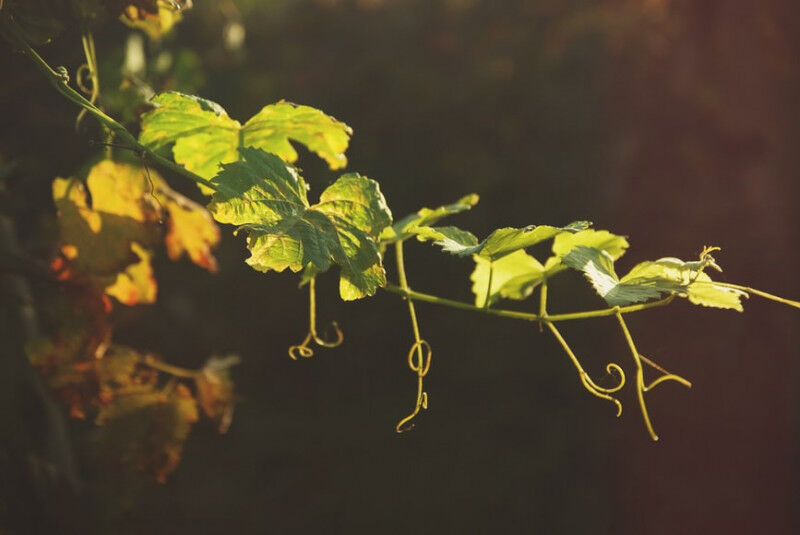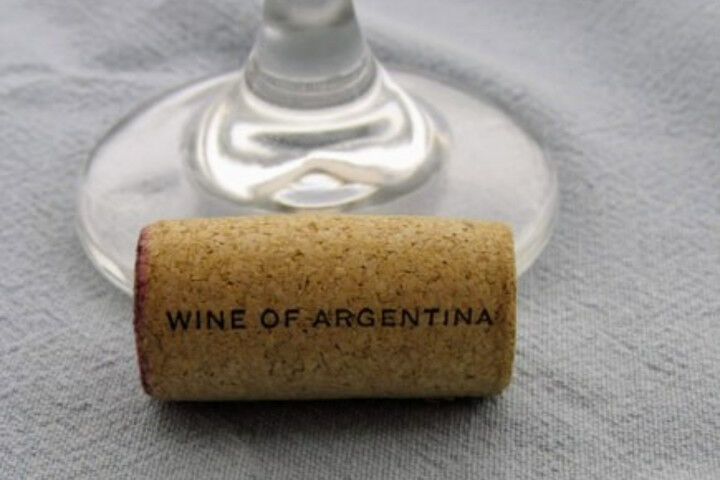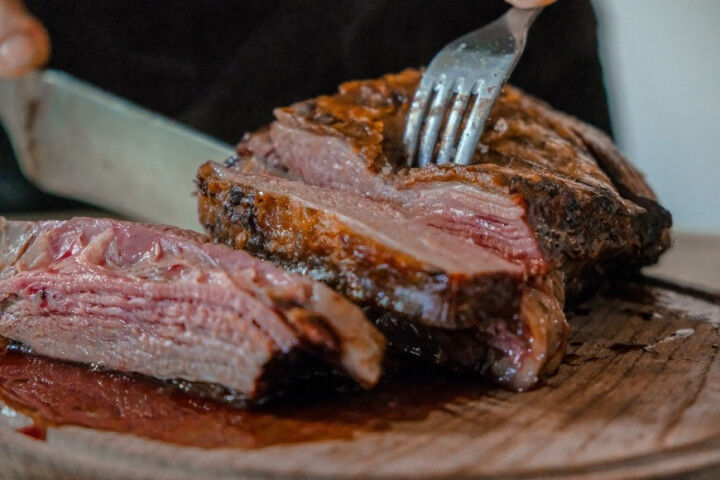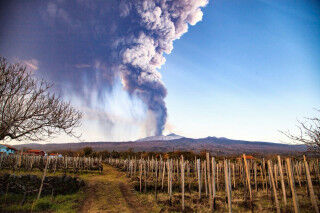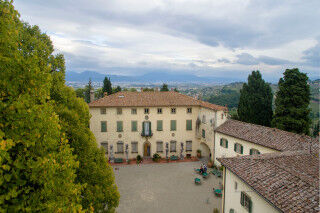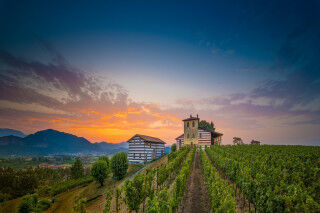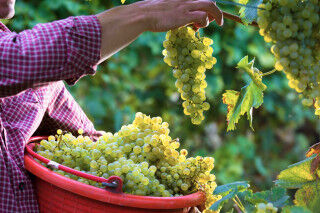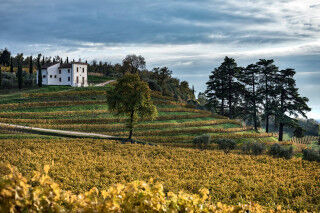Merlot and Malbec have four things in common. Firstly, they both come from southwest France. Secondly, they’re both black grapes that produce dry red wines.
Thirdly, these grapes produce very drinkable wines that are produced as high volume or prestigious styles.
Finally, researchers have found that these grapes are actually distant cousins! How they differ is their aroma and flavor profiles, food pairings, and where they are cultivated today. Read on for a look at these two popular red grapes and the wines they produce.
Merlot
Merlot is a fruity, versatile wine that vignerons around the globe use in both varietal wines and blends. In the latter style, it adds body and softness. In its homeland France, this grape is found in the iconic red blends of Bordeaux and in the Pays d’Oc.
It’s also planted widely in warm, fertile regions across the New World for high-volume, easy-drinking wines. Stand out features of Merlot are its aromas, flavors, and body making it a very food-friendly wine.
Main characteristics of Merlot
- Merlot is ruby red.
- Merlot red and black fruit aromas and flavors.
- It’s dry with medium to high acidity, soft tannins, and a medium to full body.
- When oak is used in its vinification, Merlot displays cloves, vanilla, chocolate, and toast.
- Mature Merlot has aromas and flavors of cooked black and red fruit plus dark chocolate.
Examples of Merlot:
- Guidalberto IGT, 2018, Tenuta San Guido, Tuscany, Italy.
- Castello di Ama, 2018, L'Apparita, Tuscany, Italy .
- Coevo, IGT, 20015, Cecchi, Tuscany, Italy.
Malbec
Malbec is produced as a varietal wine and also blended with other black grapes. Today, it’s the flagship wine of Argentina but it remains a key variety in its hometown of Cahors in the southwest of France. It’s also blended in some Bordeaux reds. This grape variety makes silky wines with black fruit, tobacco, chocolate, and vanilla notes.
In Argentina, vintners produce Malbec across most of its wine regions and there’s important ongoing experimentation with high-altitude styles of the wine grown in the Andes foothills.
Main characteristics of Malbec
- Argentinian Malbec is purple and displays black fruit and violet aromas and flavors.
- Cahors Malbec is ruby red and is leaner with savory, herbal notes and higher tannins.
- Malbec is dry with medium acidity, medium tannins, and a full body.
- Mature Malbec has chocolate notes as well as tobacco and sweet spice.
Examples of Malbec:
- Vie Cave Maremma IGT, 2018, Fattoria Aldobrandesca, Tuscany, Italy
- Vino Rosso, Malbec IGT, 2019, Borgo Stajnbech, Trevenezie, Italy
- Malbec IGT, 2017, Leuta, Tuscany, Italy
Merlot vs Malbec: Origin
Merlot
The roots of Merlot can be traced to the 18th century when it was first recorded in Bordeaux wine records. The story goes that it’s named after a local blackbird because of its blue-black fruit. Today, Merlot is the most widely planted grape in this region.
It dominates on Bordeaux’s Right Bank where it features in the red blends of Saint-Émilion and Pomerol. Additionally, it’s one of the main grapes in the excellent value for money Côtes-de-Bordeaux appellation, also on the Right Bank. Merlot is also a significant grape in the legendary Left Bank Bordeaux red blends where it adds fruit and soft body.
Elsewhere in France, Merlot grows in Pays d’ Oc in the South of France where it is used in IGT wines. An adaptable grape that’s relatively easy to cultivate, top-quality Merlot is found around the globe in varietal wines and blends in Washington State, Chile, South Africa, Australia, and New Zealand. Closer to home in Italy, Merlot appears in Chianti Classico blends and it’s also made as a varietal Super Tuscan wine in Bolgheri.
Malbec
Malbec hails from Cahors in the southwest of France where it’s also known as Côt. For several centuries from the middle ages onward, Malbec made what was known as “Black Wine”. This drink was favored by princes and popes alike which resulted in a very successful wine industry that only started to founder with the ascent of Bordeaux.
Today, Malbec produced in Cahors has to comprise at least 70% of the grape with other black varieties making up the difference. Nowadays, Malbec is associated with Argentina where it started to put the country on the world wine-producing map at the end of the last century. The grape arrived in Argentina via Chile in the middle of the 19th century where it had originally been grown from French cuttings. The grape experienced many highs and lows but has triumphed to become the wine of Argentina and even has its own international celebration day on April 17th. Around the world, Malbec grows in Chile, California, Australia, and South Africa. This variety also flourishes in Puglia and Veneto.
Merlot vs Malbec: Grapes
Merlot is part of an illustrious family tree. It’s the child of Cabernet Franc and an obscure grape called Magdeleine Noire des Charentes. Ampelographers have also found links to Carménère, Cabernet Sauvignon, and Malbec. It has a dark blue hue, and it buds and ripens early which is why it thrives in the cool clay soils of Bordeaux’s Right Bank.
Malbec
Malbec is a thick-skinned grape that needs more warmth and sunlight than Merlot to fully ripen. Berries are inky purple and tannic, producing rich dark fruit wines with good body. Malbec is also referred to as Auxerrois, Côt, and Pressac. In Argentina, Malbec grows on both the fertile plains where it makes fruity, full-bodied wines and in high-altitude vineyards at around 1,500 meters above sea level. At these heights, the fruit makes fruity, floral, elegant wines with refined tannins.
Merlot vs Malbec: Tasting Notes
The tasting profile of Merlot varies in different regions. In moderate regions like Bordeaux, it displays red fruit, high acidity, and medium tannins. In Left Bank blends, it adds fresh fruit and body to wine while on the Right Bank it makes bold, velvety, fruity reds. Moving into warmer areas like the Pays d’ Oc and New World regions, black fruit dominates alongside gentle acidity and tannins, and a medium to full body.
Merlot thrives on the Tuscan coast where the sun combined with cool sea breezes creates big fruit notes, deep tannins, and floral notes. Merlot’s used in blends and varietal wines.
Malbec
Malbec’s aroma and flavor profile reflects the climate of its environment. In its home of Cahors, it displays concentrated fruit balanced by firm tannins and high acidity. In Argentina, big soft fruit, a medium to full body, and medium acidity are features of Malbec grown across sunny, fertile plains.
High-altitude Malbec cultivated in the foothill vineyards of the Andes is leaner, more elegant, and more floral. Malbec used for varietal wines and red blends in Italy tends toward concentrated black fruit sweet spice, vanilla and chocolate notes, plus hints of herbs.
Merlot vs Malbec: Food pairing
With its soft tannins, lush fruity body, and balancing acidity, Merlot is an easy wine to pair with a wide range of food – from appetizers to entrées. There are two important points to keep in mind when pairing Merlot with different cuisine.
The first is the difference between the Bordeaux and international styles. In Bordeaux, Merlot-led wines are more precise and characterful than the international style because they reflect the local terroir.
On the other hand, the international style simply needs sunshine and fertile land for its big fruity, easy-drinking personality. For both styles avoid anything very sweet or spicy. These components highlight tannins and acidity while dulling fruit and body.
Salty food enhances body and fruitiness. Finally, match Merlot with more fruit concentration and alcohol with richer foods. Below are some food pairing suggestions to whet your appetite!
- Appetizers: Stuffed mushrooms; roasted potato skins; for vegetarians and meat-eaters, cheese fondue with bread, roasted potato wedges, roasted vegetables, and meatballs for dipping.
- Entrées: Lamb kebabs with roasted vegetables; pizzas with tomato sauces like Margherita; Italian dishes like gnocchi or ravioli with rich tomato or creamy sauces.
- Dessert: Chocolate brownies or crêpes.
- Cheese: Brie, gouda, parmesan, medium cheddar.
Malbec
Malbec produces medium to full-bodied wines so is a natural match with richly-flavored foods. It’s not super tannic though so it can pair well with a range of lighter meats as well as more heavy-duty dishes.
The fruity, herbaceous, chocolate and floral notes typical of Argentinian Malbec make it a good partner for slightly spicy foods which is unusual for bold red wines. The Malbec of France is more restrained yet powerful with smoky, meaty notes underlining concentrated black fruit making it ideal for rich and bold meat dishes. As with Merlot, salt in food accentuates body and fruit character.
- Appetizers: Charcuterie (including slightly spicy cuts), grilled vegetable tapas, empanadas, meat and vegetable kebabs.
- Entrées: Steak, herb-crusted lamb, pork ribs, blue cheese hamburger, Spaghetti Bolognese, fondue, creamy rice and mushroom stuffed peppers, meat or vegetarian chili, Arrabiata pasta, a range of meat, fish, and vegetarian pizzas.
- Dessert: Dark chocolate tart or mousse (the chocolate should only be a little sweet).
- Cheese: Pecorino, blue cheese, Gruyère.
